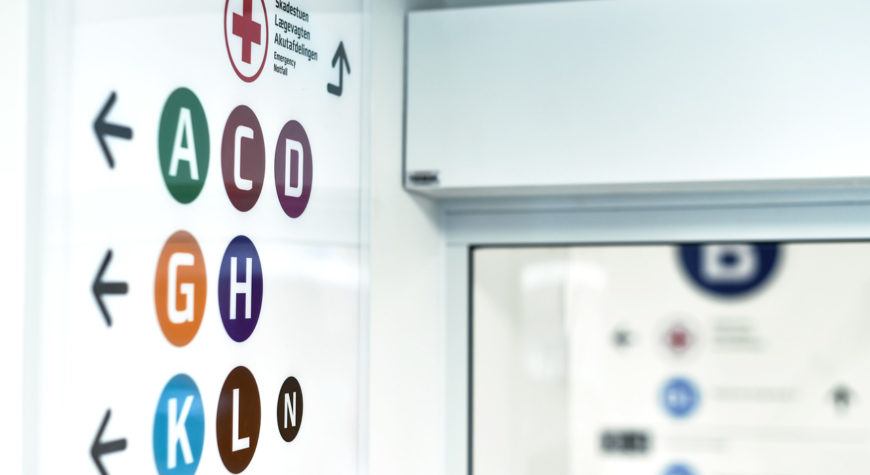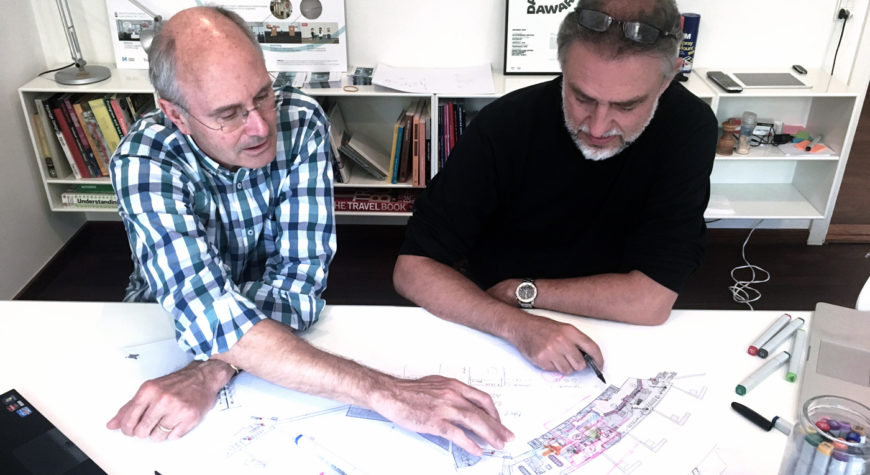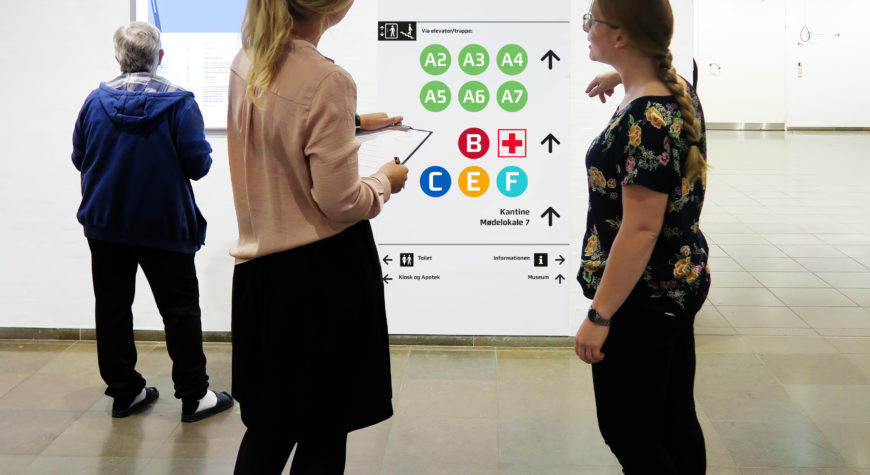It is said that challenges are the best driver of creativity. For a project for New Aalborg University Hospital, the pandemic forced the user testing of the wayfinding signage, planned to take place in a 3D cave, to be postponed due to the ban of gatherings and risk of contagion.
The solution to progress with the user testing was to conduct online interviews with each participant, while showing them a video made from the 3D model that would have been used in the cave. Read below to learn more about Triagonal’s experiences with online user testing and the pros and cons of the method.
Online user tests using 3D models – the pros and cons
Want to know more?

User testing at New Aalborg University Hospital
The New Aalborg University Hospital, NAU, is one of the new Super Hospitals in Denmark, which will be welcoming patients in the second half of 2022, and for which Triagonal has designed the wayfinding systematics and signage layout. To enable patients, visitors and staff to navigate seamlessly around the 170.000 m2 hospital, a user test of the wayfinding systematics and design was scheduled.
Click here to read our article on hospital Wayfinding and signage design.

The user test was originally planned to be undertaken in NAU’s 3D cave, having users navigating the 3D model of the hospital, guided by the signage positioned in the model. However, the COVID-19 pandemic forced us to think creatively and instead, we performed the user tests online where we could showcase the video of the 3D model by sharing our screen with the test person.
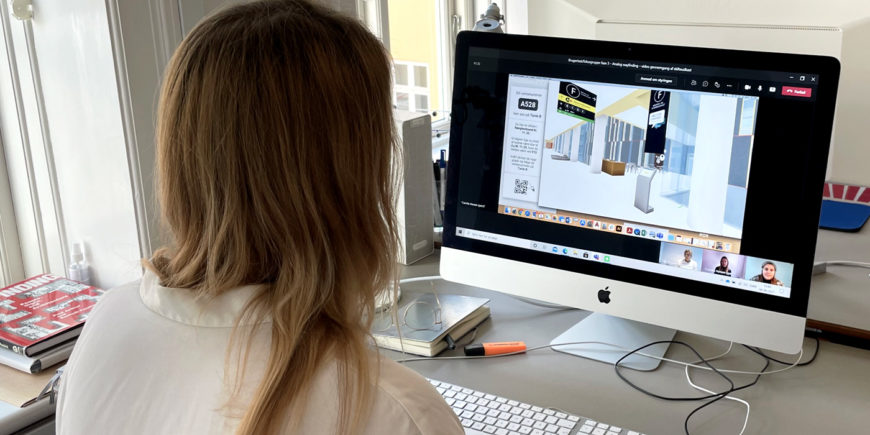
The User Journey
For the purpose of the test, signs were added to a specific user journey in the 3D model, which allowed us to test the signage and systematics before applying it to the rest of the hospital. Having placed the signage in the 3D model, the Danish company Epiito created a video recording of the specific user journey in the model.
As a part of the user test, participants were provided with a letter of referral, the receipt they would have received when having checked in at a registration kiosk at the hospital and the information screen in the waiting area, in addition to the signage. The success of the wayfinding experience is highly dependent on the integration of these elements and the wayfinding signage. Adding these elements to the journey provided a more realistic user journey experience.
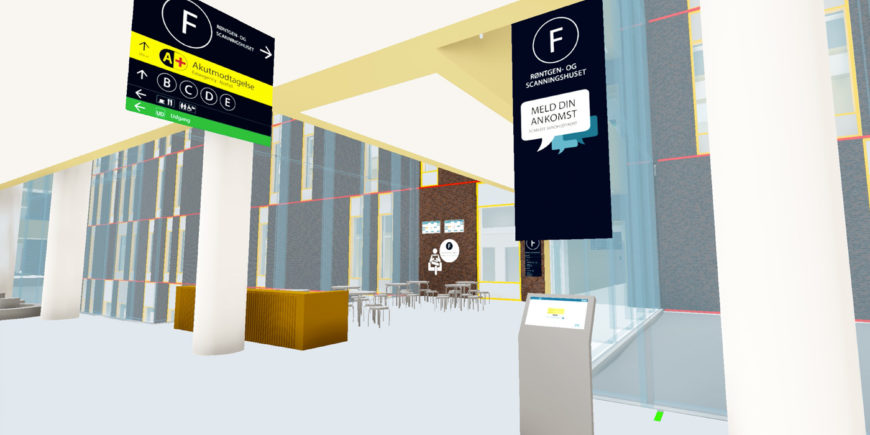
The journey chosen was a typical user journey, where the test person had an appointment at the Diagnostic Imaging Department. The user would have to find the central waiting area, common for all departments, and wait there until they were called forward via an information screen. From there, the user would be navigating towards a decentral waiting area for the specific department that they had an appointment at. Here they would be called forward by medical staff.
Are you curious to know how we can help you test our solutions before implementation? Contact our Director of Health, Peter Donner, for more information.
Advantages of testing with a 3D model
In this specific case, we had a video made of the route that the users would be navigating. This was mainly due to potential technical issues with navigating directly in the 3D model via a video link. By making the video of the route beforehand, we made sure that the route shown was the same for all users. This, however, meant that the users did not have the opportunity to decide for themselves in which direction they would go.
Besides the several general advantages of user testing, testing with a 3D model particularly excels in four ways:
- This way of testing enables us to easily conduct user tests remotely with users far away and to demonstrate the spatial feeling of a space without the users actually being on-site
- User testing in the 3D model is particularly suited for projects where the buildings are still under construction and there are no existing buildings to test within
- Performing a user test from their own homes or offices is likely to make the test user feel calmer and more confident, which in this case was expressed in the elaborate comments and engagement in the test
- Virtual tests enable user feedback without having to produce or mount any of the signs in the building
By implementing wayfinding signage into a limited, but carefully selected area of a 3D model, it provides a solid basis for examining the wayfinding systematics as a whole.
3D model testing works very well in terms of testing the wayfinding systematics prior to implementation. A before/after-study can reveal the actual performance of the new wayfinding strategy. Read how we did that and how it went at Randers Regional Hospital here.
Issues to consider when testing with a 3D model
As for most cases of user testing, some factors will differ from the user testing to the real-world wayfinding experience. Even though there are several advantages of testing wayfinding signage in a 3D model, there are circumstances that need to be considered before implementing the user feedback.
- In most cases there is no noise, no other people, sometimes no interior or wall textures and other sensory stimulations in the 3D model to divert focus from the signage. In reality such factors will add a layer of complexity to the navigation process
- When testing hospital wayfinding the outcome will often deviate slightly from reality, since the state of mind of the users is different than if they were going to a real appointment. In the test they were not actually ill or in need of hospital services and therefore their mental state was not as affected in a test situation as it often is in a real wayfinding situation
- In some cases, the quality of the video might not be sufficient to test for legibility and reading distances for the different sign types. Therefore, comments related to this should always be tested using prototypes either on-site when possible or in a similar setting
It’s always hard to consider all aspects of user testing and to which extent it can be compared to reality. However, considering both the advantages and issues of consideration raised we perceive the online 3D video tours to be an effective tool for facilitating user tests of our wayfinding solutions.
At Triagonal, we have extensive experience and knowledge on how to perform the most valuable user tests, adapted to and varying from project to project, and we are pleased to have added this new method to our tool box. We foresee that the method will become relevant in many future projects when e.g. working on international projects like the Başakşehir City Hospital project in Istanbul, Turkey.
Do you want to know more about the opportunities for user testing in your project? Get in contact here.

